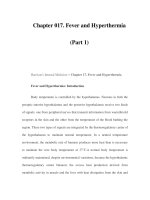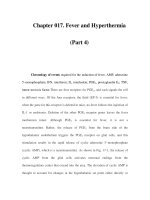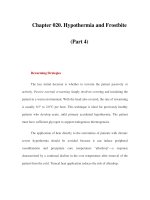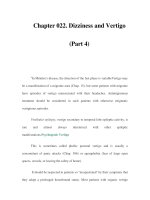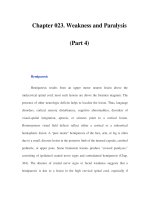Chapter 053. Eczema and Dermatitis (Part 4) docx
Bạn đang xem bản rút gọn của tài liệu. Xem và tải ngay bản đầy đủ của tài liệu tại đây (56.69 KB, 5 trang )
Chapter 053. Eczema and
Dermatitis
(Part 4)
Figure 53-2
Dyshidrotic eczema. This example is characterized by deep-seated vesicles
and scaling on palms and lateral fingers, and the disease is often associated with
an atopic diathesis.
The evaluation of a patient with hand eczema should include an assessment
of potential occupation-associated exposures. The history should be directed to
identifying possible irritant or allergen exposures.
Hand Eczema: Treatment
Therapy of hand dermatitis is directed toward avoidance of irritants,
identification of possible contact allergens, treatment of coexistent infection, and
application of topical glucocorticoids. Whenever possible, the hands should be
protected by gloves, preferably vinyl. The use of rubber gloves (latex) to protect
dermatitic skin is sometimes associated with the development of hypersensitivity
reactions to components of the gloves. Patients can be treated with cool moist
compresses, followed by application of a mid- to high-potency topical
glucocorticoid in a cream or ointment base. As with atopic dermatitis, treatment of
secondary infection is essential for good control. Additionally, patients with hand
dermatitis should be examined for dermatophyte infection by KOH preparation
and culture (see below).
Nummular Eczema
Nummular eczema is characterized by circular or oval "coinlike" lesions,
beginning as small edematous papules that become crusted and scaly. The etiology
of nummular eczema is unknown, but dry skin is a contributing factor. Common
locations are the trunk or the extensor surfaces of the extremities, particularly on
the pretibial areas or dorsum of the hands. It occurs more frequently in men and is
most commonly seen in middle age. The treatment of nummular eczema is similar
to that for atopic dermatitis.
Asteatotic Eczema
Asteatotic eczema, also known as xerotic eczema or "winter itch," is a
mildly inflammatory dermatitis that develops in areas of extremely dry skin,
especially during the dry winter months. Clinically, there may be considerable
overlap with nummular eczema. This form of eczema accounts for a large number
of physician visits because of the associated pruritus. Fine cracks and scale, with
or without erythema, characteristically develop in areas of dry skin, especially on
the anterior surfaces of the lower extremities in elderly patients. Asteatotic eczema
responds well to topical moisturizers and the avoidance of cutaneous irritants.
Overbathing and the use of harsh soaps exacerbate asteatotic eczema.
Stasis Dermatitis and Stasis Ulceration
Stasis dermatitis develops on the lower extremities secondary to venous
incompetence and chronic edema. Patients may give a history of deep venous
thrombosis, have evidence of vein removal, or varicose veins. Early findings in
stasis dermatitis consist of mild erythema and scaling associated with pruritus. The
typical initial site of involvement is the medial aspect of the ankle, often over a
distended vein (Fig. 53-3). Stasis dermatitis may become acutely inflamed, with
crusting and exudate. In this state, it is easily confused with cellulitis. Chronic
stasis dermatitis is often associated with dermal fibrosis that is recognized
clinically as brawny edema of the skin. As the disorder progresses, the dermatitis
becomes progressively pigmented, due to chronic erythrocyte extravasation
leading to cutaneous hemosiderin deposition. Stasis dermatitis may be complicated
by secondary infection and contact dermatitis. Severe stasis dermatitis may
precede the development of stasis ulcers.
Figure 53-3

